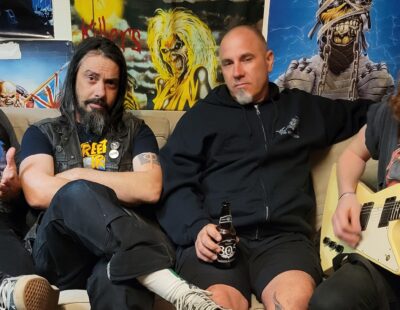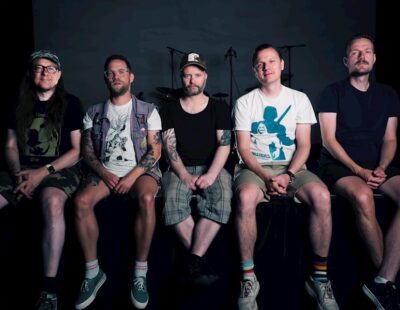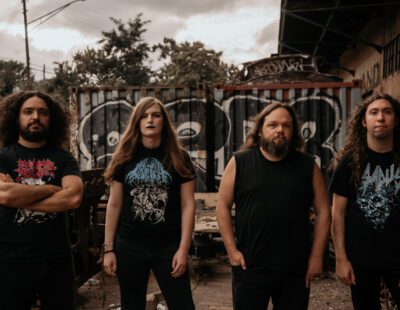Pure Hell are known for three things: 1) being the first all African-American punk band; 2) having a wickedly cool band name; and 3) being the focus of a very popular online photo from 1978, depicting the quartet with dyed, glow-in-the-dark, chemically-straightened hair and ill-advised face paint. Formed in Philadelphia in 1974, they were inspired by both the political and socially-charged climate and the musical rebellion they admired within the proto-punk scene. The band was never a commercial success in North America, but within New York City’s notorious ’70s glam/punk enclaves, they were well-respected and considered an inspiration, cultivating a following in England via their single, 1978’s cover of Nancy Sinatra’s “These Boots Are Made for Walkin’” and the B-side, “No Rules.”
Legal and personal disputes caused Pure Hell’s debut album, 1980’s Noise Addiction, to be shelved for 28 years, and selected tracks from their second, 1992’s never-released The Black Box (produced by Motörhead’s Lemmy Kilmister with contributions from members of Nine Inch Nails and LA Guns) were only recently made available online. The band initally broke up in 1980, but later regrouped in Los Angeles in 1990, and despite original drummer Michael “Spider” Sanders’ death in 2008, the band continues on, playing select dates around the New York/Philadelphia area and in Europe.
The Deciblog emailed founder/vocalist Kenny “Stinker” Gordon, who is currently writing a book on Pure Hell, to get some background on this legendary band.
How did you meet the other members in Philadelphia?
Michael [Sanders] moved into my house in 1972 and we formed a bass and drum rhythm section. By 1974, after playing a talent show at my college prep school as Pretty Poison, I renamed the band Pure Hell before venturing up to New York City that same year.
Philadelphia had a clique of musicians and recreational drug users that hung out around the Samson Street Village and went to concerts, but we grew up in the same vicinity. We had similar perceptions and taste in music, and leaned toward the musical innovations that certain bands and artists at that time were making. We had album collections comprised of Miles Davis’ Live Evil, The Mahavishnu Orchestra, Pink Floyd’s Relics, the Stooges, and Hendrix. Being so close to New York, we had access to imports.
You are known as the “first black punk rock band.” I imagine that while all kids are influenced by the popular music of their generation, It must have been a bit odd because not too many African-American rock bands existed during that time. What was the reaction from your friends and family members when you started playing punk rock?
Actually, my mother bought the first bass and amplifier I had. It was during the Civil Rights era at the end of the 1960s and into the ’70s. It was obvious that people like Gil Scott-Heron and Alice Cooper were making statements. Punk rock was a movement, breaking the remaining restraints of convention after the “love and peace” thing of the ’60s. We were ahead of our time, and most people around us wanted to go come along for the ride.
There is a pretty famous 1978 picture of the four members wearing makeup and various colored hair. Who was responsible for your look?
This model named Charlotte from Switzerland and Rose Taylor [Mick Taylor’s ex-wife]. When we were in London, she took us to Ricci Burns Salon on Kings Road to make us over, like their friends the Rolling Stones.
Were there any concerns that people would look at you as more of a novelty as an all-black punk band, not taking your musical talent into account?
At our peak, we were one of those bands that thrived on blistering an audience. Unfortunately the “cause” of that era simmered, and the original scene died with Sid [Vicious] by 1980. Some adapted to the radio-friendly industry; others came apart simply by burning both ends of the candle. We had the spotlight to display the musical substance of the band and, frankly, a couple of us decided not to take full advantage of the opportunity. I think it “concerned”some people because they couldn’t figure how we were involved in the very essence of punk, like Television and Johnny Thunders before he formed the Heartbreakers. Though the original Pure Hell lineup released one album before disbanding in 1980, Spider and I put the band back together for extended recordings [in 1990] before he died. I currently have prominent irons in the fire that don’t want to talk about, as I wouldn’t want to jinx it.
I thought the sound on the released tracks from The Black Box wasn’t specifically “punk,” but a hybrid of metal and punk. Did working with Lemmy , and/or your move from New York to L.A. have anything to do with the heavier, more muscular sound?
L.A. had character during the late ’80s through the mid-’90s. It is the American film and entertainment industry, right? Lemmy produced and played on some of those extended recordings because Motörhead was on [1977’s] Geef Voor New Wave compilation LP along with the Adverts, Generation X, the Sex Pistols and others. Lemmy played bass with the Damned under the name the Doomed in 1979. So, he worked with us, but the influence was our own.
We were just flexing our weight and clout of our friends that we were working with. Different genres of music had risen since the birth of punk. The sound is what it is. The [Los Angeles] riots were happening between some of those sessions.
There were some legal issues pertaining to the delayed release of Noise Addiction. How was it received when it finally saw the light?
Better than I would have imagined. It was surprising for Henry Rollins to be so enthused [that] he placed it on his playlist at Indie 103.1 FM in Los Angeles, and the units moved within European markets. It’s a shame such a fiasco took place early on during our Holland and England debut tour in 1978. Back then, there were too many irons in the fire of the negative kind that had to be gotten rid of.
Where did you find the most acceptance of your music, and besides the upcoming book project, what are your future plans?
Europe was where we had the largest platform, so the prominent irons currently in the fire include a possible return there after many years, and the same for California.







